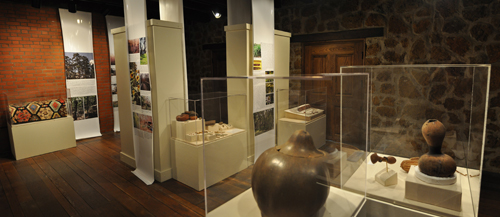Sacred Spaces: Connecting with the Land
September 2013 - March 2014
Sacred Spaces: Connecting with the Land
What landscapes do people identify as sacred? How do people assign meaning to a place? From the backyard vegetable garden to a favorite vista, we establish personal connections with our environment, and connections that are a reflection of our group identity. This exhibit uses descriptions of Texas from diaries dating to the late 1600s, and contemporary journals of the East Texas landscape to explore the many ways we connect with our environment.
In the late seventeenth century, Franciscan priests recorded some of the earliest written descriptions of the East Texas landscape. Traveling into the northern borderlands of the Spanish Empire, the explorers followed Native American trails that we now refer to as El Camino Real north from Mexico City, across Texas, and into northwest Louisiana. Officials and clergy recorded an ‘inventory’ of the new land. But they also recorded some of their reactions to the unfamiliar plants and animals, and new cultures. The diaries are a window on their point of view as are the place names they scattered across Texas. Place names, such as the Trinity River, remind us of the spiritual heritage of the earliest chroniclers of Texas and remain a part of our Texas heritage.
In 2011, twenty-five volunteers took another look at the landscape of eastern Texas with an exploration of their environment and their spiritual connection to the land. The pilot project, designed by Kelley Snowden and Tom Segady of Stephen F. Austin State University, focused on seven Christian congregations in Nacogdoches, Texas and used a study method known as Photovoice. Snowden and Segady gave each volunteer a ‘point and shoot’ camera and a journal. Responding to a set of questions relating to their spiritual relationship with the land, volunteers chose places to photograph and to write about in their journals. Taken together, the 329 collected photographs and journal entries illustrate that faith has geography. The project photographs are a mix of natural, public and private landscapes.
The seventeenth century diarists recorded the things that mattered to them and connected with new places, things and people through the lens of their religion. The Photovoice project asked volunteers to train their spiritual lens on a very familiar landscape to identify the things that matter. Presented side-by-side along with objects that speak to our connection with the land, the journals of the past and the journals of the present reveal our ongoing connection to, and interaction with, our environment.